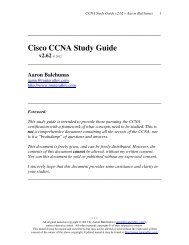OSI Reference Model - Router Alley
OSI Reference Model - Router Alley
OSI Reference Model - Router Alley
You also want an ePaper? Increase the reach of your titles
YUMPU automatically turns print PDFs into web optimized ePapers that Google loves.
<strong>OSI</strong> <strong>Reference</strong> <strong>Model</strong> v1.31 – Aaron Balchunas<br />
8<br />
Encapsulation and Layered Communication<br />
As data is passed from the user application down the virtual layers of the<br />
<strong>OSI</strong> model, each layer adds a header (and sometimes a trailer) containing<br />
protocol information specific to that layer. These headers are called Protocol<br />
Data Units (PDUs), and the process of adding these headers is called<br />
encapsulation. Note that in the TCP/IP protocol suite only the lower layers<br />
perform encapsulation, generally.<br />
For example, a Transport layer protocol such as TCP will add a header<br />
containing flow control, port numbers, and sequencing. The Network layer<br />
header contains logical addressing information, and the Data-link header<br />
contains physical addressing and other hardware specific information.<br />
The PDU of each layer is identified with a different term:<br />
Layer<br />
PDU Name<br />
Application -<br />
Presentation -<br />
Session -<br />
Transport<br />
Segments<br />
Network<br />
Packets<br />
Data-Link<br />
Frames<br />
Physical<br />
Bits<br />
Each layer communicates with the corresponding layer on the receiving<br />
device. For example, on the sending device, source and destination hardware<br />
addressing is placed in a Data-link header. On the receiving device, that<br />
Data-link header is processed and stripped away (decapsulated) before<br />
being sent up to the Network and other upper layers.<br />
Network devices are commonly identified by the <strong>OSI</strong> layer they operate at;<br />
or, more specifically, what header or PDU the device processes.<br />
For example, switches are generally identified as Layer-2 devices, as<br />
switches process information stored in the Data-Link header of a frame,<br />
such as Ethernet MAC addresses. Similarly, routers are identified as Layer-<br />
3 devices, as routers process logical addressing information in the Network<br />
header of a packet, such as IP addresses.<br />
* * *<br />
All original material copyright © 2012 by Aaron Balchunas (aaron@routeralley.com),<br />
unless otherwise noted. All other material copyright © of their respective owners.<br />
This material may be copied and used freely, but may not be altered or sold without the expressed written<br />
consent of the owner of the above copyright. Updated material may be found at http://www.routeralley.com.

















